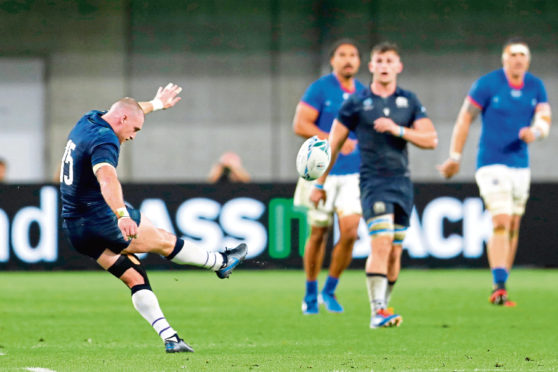Modern media being what it is, it was all over the place within a couple of minutes of it happening.
BT Sport themselves tweeted out film of Finn Russell’s audacious “nutmeg” try for Racing 92 against Munster, just in case non-subscribers might miss it.
Finn’s had three stellar performances in three weeks since he returned to duty for the French club, in the Paris derby against Stade Francais and then two in the Heineken Cup, against Saracens and Munster.
Russell’s try against Sarries’ 3rd team was also a beaut, twice involved before the finish with the usual catalogue of dummies, superbly timed delivery and acceleration.
A little closer to home – in more than just the geographical sense – are Stuart Hogg’s opening performances for Exeter, his new club since leaving Glasgow in the summer.
In his first three games – after texting Rob Baxter in the aftermath of the defeat to Japan in the Rugby World Cup to insist he wanted to play immediately – Hoggy gained the most metres of any player in the Gallagher Premiership.
Of course, a full-back does get more metres usually because he runs unchallenged fielding so many deep kicks, but Hoggy was more than 100m better than his nearest challenger, the not-remotely-shabby Charles Piutau of Bristol.
Hoggy was more subdued against his old mates on Saturday in the Heineken but that was understandable, and the Chiefs didn’t need him to be outrageous.
Anyway, can they do this on a rainy night in Yokohama? They didn’t, unfortunately, and it’s galling even now to see them play so freely for their clubs after underwhelming us so much during the Rugby World Cup.
Hoggy and Finn are the poster boys of Scottish Rugby. These are two of the most exciting players this country has ever produced. Hogg might be the best player in Scottish rugby history already, and he’s only 27 and in his prime.
His personal highlight in Japan? A 40 metre drop goal against Samoa. It was a majestic thing, but we want to see Hogg doing what he does best, frightening the life out of opposition defences.
Russell had a slightly better RWC, creating two tries against Samoa and scoring that false-dawn opening try against Japan. But for a player of his calibre, coming into the tournament off the outrageous second half at Twickenham in March, he didn’t really advance his reputation as a gamebreaker.
Hoggy and Finn are the points of difference for Scotland in the international game – few players have their attributes and abilities. Did Scotland really make the most of them in the most important tournament of the entire decade?
Scotland’s switch to a more kicking-orientated game in 2018-19 was an understandable move. The all-singing, all-dancing style of Gregor Townsend’s first 18 months – that “fastest rugby in the world” thing – had a short shelf life, as do all tactical plans to today’s over-analysed rugby world,
But the switch clearly didn’t work. Scotland won six out of 13 tests during 2019, and they were against Italy, Georgia twice, France, Samoa and Russia.
In addition, it’s reasonably clear that apart from 40 minutes at Twickenham in March, the style did not make the most of our two best attacking assets. Hogg’s absence for much of the 6 Nations might be a caveat, but nothing that happened in Japan showed that the tactical plan suited him or Russell.
And since they’ve returned, moving to what one assumes is a sympathetic gameplan – they’re being paid handsomely, so one can reasonably assume their clubs want to showcase them – they’ve been lights out.
Scotland can’t unfurl a 20 stone, 6ft 10in second row to make up the obvious power gap – they have one but he doesn’t seem to want to play international rugby anymore. They have to develop a plan that maximises their strengths.
It won’t change the personnel deficiencies that Scotland suffer from. But they’ll be much more fun to watch, and I bet they win more than they’ve done kicking the ball away constantly.
The curiousity with Rennie
Dave Rennie is a good man, and a fine coach. He leaves Glasgow next summer with the team improved in a lot of ways.
But he’s had some curious personnel issues. There’s the Huw Jones/Alex Dunbar one…these were Scotland’s first choice centres when Dave came, now one’s with Brive in France and the other seems to want to go back to play in the Currie Cup in South Africa.
Then there’s the question of Greg Peterson and Brian Alainu’uese. Two big locks with the kind of bulk and strength you’d really want when facing a team like, say, the Exeter Chiefs.
The American and the Samoan were allowed to leave Scotstoun in last mid-season having barely featured under Rennie.
Scott Cummings has developed hugely and Rob Harley is a Warriors legend but the power deficit at Sandy Park on Saturday was every bit as big as it was when the clubs met two years ago – you could argue it’s now greater.
Those two big locks were no world beaters. But neither are Exeter’s.
